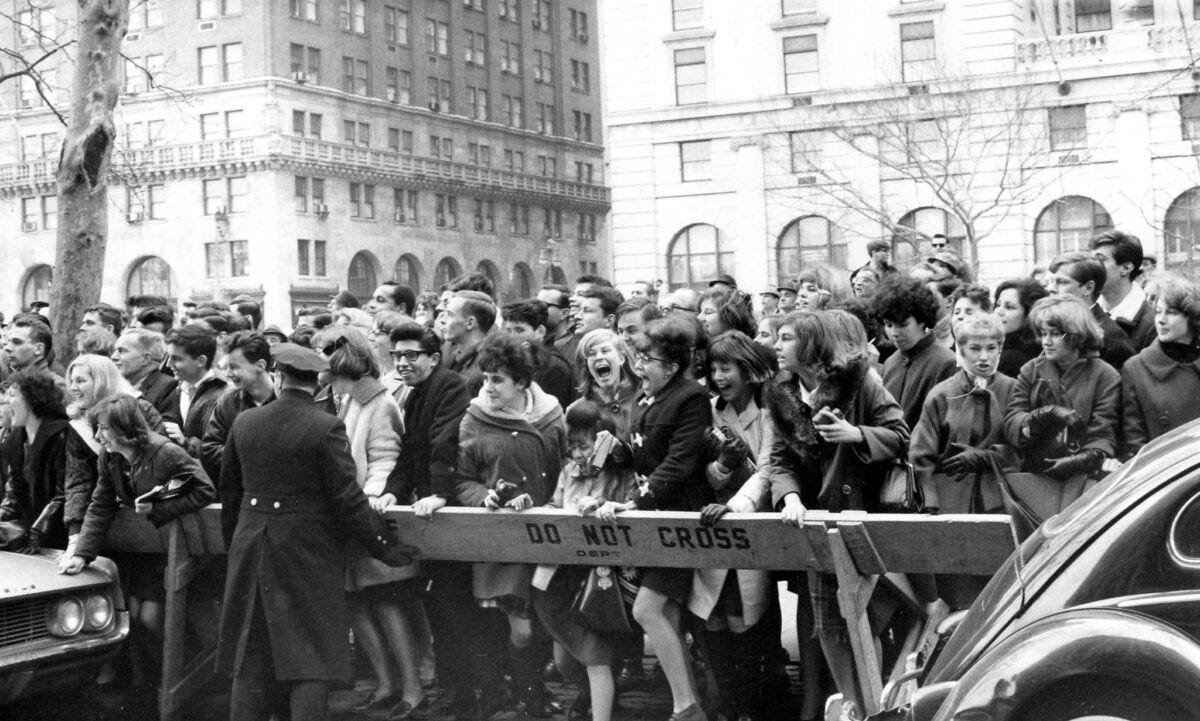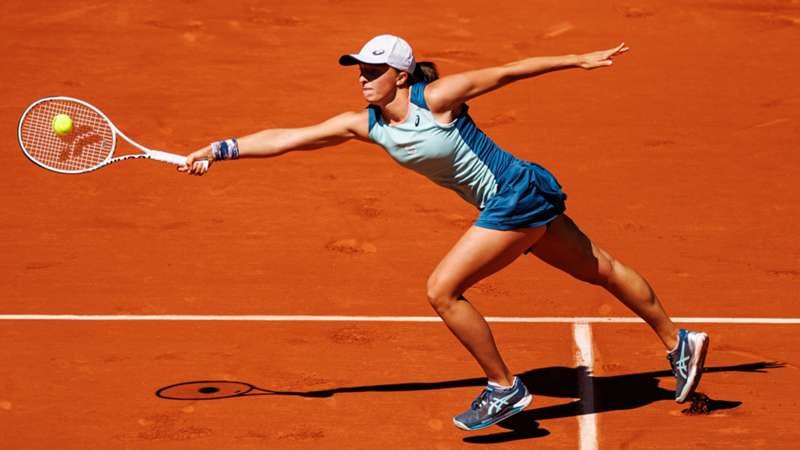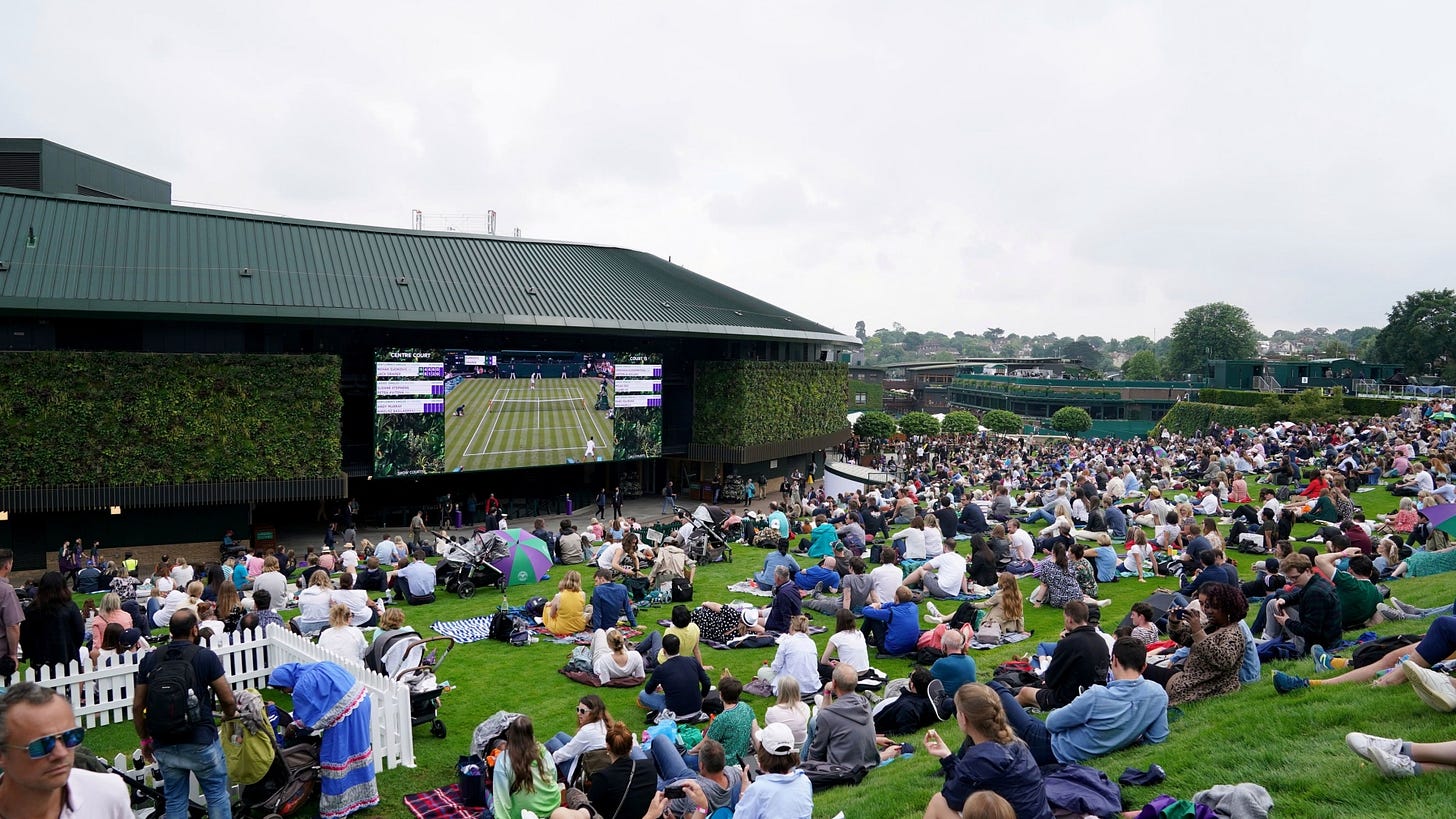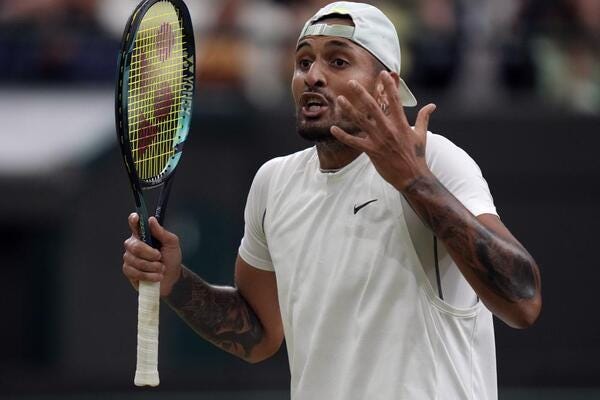Screaming, crying, and throwing up: how fangirls solve tennis's modernisation crisis
Why the tour is missing out when it fails to consider the female demographic
Tennis is, as we all know, undergoing something of an identity crisis. Now, reader, I hear you groaning at the very mention of another one of these “future of tennis” takes. I did say I was a tennis journalist after all, and if I’m going to proceed with my substack on those fraudulent credentials, I suppose I’ve got to put in my time covering these well worn topics. For some reason, all three of my previous pieces have also been about identity of some sort: the identity of a player, the identity of a nation, the identity of a brand. So I suppose it’s fitting that I discuss the identity of tennis.
You would think that a sport that’s existed since the Victorian era would have something of a cohesive identity, and to an extent this is true. I have previously discussed the image of tennis as a “gentleman’s sport” with a unique sense of etiquette and tradition. However, recent market pressure (read: the tennis demographic stagnating to the point it is literally dying) has forced tennis to reconsider this “stuffy” image in favour of modernisation. Thus is tennis’s central dilemma: how to modernise to keep the sport relevant without losing its core identity.

The current conversation has focussed mainly on either developing new social media strategies, cutting down on archaic traditions, or on spotlighting players who are “good for the sport.” However, I believe these approaches are missing something: they neglect what demographics are “up for grabs” so to speak. These suggestions, while potentially easing the issue a bit, ultimately appeal to people who already watch tennis. Instead, I assert tennis’s promotional bodies should focus on expansion to a new demographic, previously underserved within the wider sporting community: women.
In order to make my case for a promotional strategy that targets female fans, I will first explain why female fans are currently excluded from the tennis space. I outline why the marginalisation of female modes of engagement with the sport actively harm the ability of the sport to appeal to new audiences and grow. I then examine the efficacy of the current strategy of rule changes and spotlighting players who are “good for the sport” in contrast to a more inclusive approach. Finally, I outline a potential new marketing strategy for tennis promotion in conjunction with a personal praxis for coping with the patriarchal strains of the tennis space.
Female Identity in Sporting Fandom
In order to argue that tennis’s promotional bodies should increase their appeal to female fans, I must first explain why this is not the case in the status quo. I first examine the way in which masculinity is assumed to be the default both within a patriarchal society as well as in traditionally masculine spaces like the tennis fandom. I then outline the overemphasis on “rational” masculine modes of engagement with the sport, as deemed as more legitimate than “emotional” female approaches. I conclude that this subtle bias ultimately makes tennis more difficult for female fans to engage with.
Now I must clarify here, of course, that intellectual rationality is not solely the domain of men, nor is excessive emotion solely the purview of the female. Men are, of course, capable of approaching fan content through an emotional lens just as much as women are capable of taking a “rational” tact. What I mean when I ascribe earnest emotionality to be a feminine trait is that this way of approaching fan content is frequently associated with women. It is, of course, also a given that not all men are reifying the rhetoric I talk about in this piece. I am discussing a systemic trend that I have absorbed in sports spaces rather than focusing on individual deeds.
Sporting fanbases, in general, are traditionally masculine spaces. Sport itself highlights traditionally masculine qualities like strength, aggression, and competition. However, these qualities are in direct contrast to ideal female traits like gentleness, beauty, or a nurturing instinct. This means that traditional female approaches are already at a disadvantage when it comes to sporting analysis–femininity is already at a contrast with what is expected within sporting fanbases. This places female fans in a tricky position of having to reject ostensible femininity in order to conform with what is expected within sporting spaces.
Maria Burton Nelson describes this as the “femininity game.”
How can you win if you’re female? Can you just do it? No. You have to play the femininity game. Femininity by definition is not large, not imposing, not competitive. Feminine women are not ruthless, not aggressive, not victorious. It’s not feminine to have a killer instinct, to want with all your heart and soul to win— neither tennis matches nor elected office nor feminist victories such as abortion rights. It’s not feminine to know exactly what you want, then go for it. Femininity is about appearing beautiful and vulnerable and small. It’s about winning male approval.

The rejection of femininity within the tennis fanbase manifests in a plethora of ways. It’s the constant interrogation of whether female fans are truly in it for the sport, or just want to sleep with the players. It’s the rejection of non “rational” modes of engagement as irrational and overly emotional. It’s the way male fans will mock women as simply “uwuing” over their favourite player–with the implication that this is a less authentic way to enjoy sport. Women are portrayed as spouting stock phrases like “screaming, crying, and throwing up,” rather than active legitimate participants in sporting spaces. Female fans are expected to yield to “rationality” as if we aren’t all engaging in the most irrational act of all–supporting a random person who hits fuzzy yellow balls around for a living.
Now, dear reader, you might be wondering: why is May suddenly so against rationality? This is a good question, and it’s not just because I have a vendetta against my statistics professor for making me wake up at 8am on a Friday. Returning to the “feminine game,” male rationality is frequently juxtaposed with female irrationality, with the ultimate conclusion being that the masculine approach is more legitimate. This is a subtle cultural thing I’m talking about, the kind of bias that seems invisible unless you either look hard for it or are actively harmed by it.
Sandra Bern explains how subtle otherisations of femininity proliferate, stating that “men in power . . . have used their position of public power to create cultural discourses and social institutions that automatically privilege male experience and otherise female experience.” I do not think it is a coincidence that most of the big “pundit” accounts on tennis twitter are admined by men (with obvious notable exceptions). The way in which the current power hierarchy of tennis twitter operates favours the predominantly male modality of engaging with the sport via statistics or “objective” analysis. It is something glaringly obvious that I feel is easy to be blind to if these discourses are created to favour your experience. However, the systematic otherisation of female experience is apparent in the way non-quantitative or “emotional” approaches are frequently sidelined.
Now of course, statistical analysis and punditry are definitely valid ways to consume tennis content. However, they are not the only way–making a fancam is just as valid a mode of engagement as is publishing an excel spreadsheet. The rhetoric that young female fans are somehow to be taken less seriously because they express their emotion around sport in a different way is preposterous to me. And perhaps, you might argue, this isn’t occurring. However, when examining the “default” tennis fan (usually a middle aged guy), it becomes clear that tennis is a masculine space in which femininity is considered an aberration and intrusion.
I think a particular quote from Sylvia Plath explains this lack of neutrality afforded to women in the most accurate way I can articulate:
Being born a woman is an awful tragedy. Yes, my consuming desire to mingle with road crews, sailors and soldiers, bar room regulars—to be a part of a scene, anonymous, listening, recording—all is spoiled by the fact that I am a girl, a female always in danger of assault and battery. My consuming interest in men and their lives is often misconstrued as a desire to seduce them, or as an invitation to intimacy. Yet, God, I want to talk to everybody I can as deeply as I can. I want to be able to sleep in an open field, to travel west, to walk freely at night.
In the context of tennis, this presents as an inability to engage with the content because your status as a “true fan” is constantly interrogated. I want to be an anonymous fly on the wall in the tennis space. I want to just exist as I am with my own ideas and analysis. Instead, it’s constantly assumed that my interest in male tennis players is physical attraction–the “desire to seduce them, or as an invitation to intimacy.” My love of the sport is constantly interrogated and poked at to the point I begin to question if I can even count myself as a “true fan.” As twitter user @_sashayed eloquently puts it, I just want to Watch the Fucking Game in Peace. This is unfortunately difficult to do when you are a woman in a traditionally masculine space, and your right to be there at all is constantly interrogated.

When I engage with sports, I feel as though I’ve entered a bar on a fake ID, and the bouncer could kick me out at any moment. Sometimes I am able to forget about the way women are perceived for long stretches of time, but inevitably someone will condemn either the way in which women engage with sport for being “cringe”--or worse, will reify misogynistic logic in the way they talk about women in the sport. It feels like a cosmic joke to have to put up with misogynistic quips about motherhood or female sexuality all because women’s tennis is supposedly more progressive than other sports. It’s humiliating to be subjected to these expectations, and an insult to be expected to stay silent about it for fear of upsetting the balance of carefully cultivated irony that tends to surround masculine spaces like sports.
I’ve been harassed off of twitter twice for voicing this concern. Regardless of how you feel about me, I certainly do not believe that I deserved to have my appearance publicly picked apart or to be told that I don’t deserve rights as a woman. It was truly a wakeup call to me how ingrained this rhetoric is–that women cannot be full and authentic fans of sports–that people with large followings can reproduce these oppressive logics with seemingly few repercussions. It feels suffocating to be told to just brush it off, but in equal measure I feel unable to discuss it because of the past harassment I have faced. So, in a sense, this is an article I’m extremely nervous to write. It’s a bit of a risk to take, and I appreciate you taking the time to read my views even if we might happen to disagree.
Tennis’s Shrinking Demographic
Now that I’ve established the way in which femininity is currently marginalised within the tennis fanbase, I want to examine present approaches to the current demographic decline of tennis. You may have just skimmed the previous section and shut off your brain because my pseudo-feminist babble seems manufactured or whiny. And, honestly, fair enough! However, I want to make a pragmatic case as to why the rejection of feminine approaches to sports fandom is actively hurting tennis in general, and by association its traditional audience.
I am sure we are all by now familiar with the cottage industry of think pieces focusing on the future of tennis–in particular the necessity of the sport to adapt to modernity. This question of how tennis ought to expand to a new audience has frustrated me since it was brought to my attention. There are many women who are already willing to engage with the sport, travel to tournaments, and produce fan content. They are simply not the people that the marketing brains behind the sport deem “viable” as a demographic. Discussions of the appeal of “bad boy” players or whether we should make all slam rounds BO3 feel like squabbles over a tiny amount of potential fans when compared to the staggering amount of women who feel turned off from sports solely due to the otherisation of women in sporting fanbases.
The present ATP approach seems to conform much more to embracing “bad boy” personas who might help the sport shed its stuffy image. One of the players who comes up most frequently is Nick Kyrgios, who I note at this time is unceasingly promoted by the ATP and other tennis media despite facing a court date for domestic abuse charges. Kyrgios is who a large swath of the tennis mainstream want the future of tennis to be–an embodiment of the patriarchal and largely anti-woman trends currently extant in the tennis fanbase. And I don’t say this as if it’s a conscious male-supremacist plot or whatever. I think it’s a subconscious attraction to the status quo. Unfortunately, the status quo is the enforcement of tennis as a male dominated space point blank.

The issue is that Kyrgios is not actually drawing new people into the sport. The demographic that Kyrgios appeals to with his brash displays of masculinity and aversion to “softness” is a demographic already well catered to by the sporting establishment–middle aged men. Indeed, the “on court bad boy” persona is one that only works for men, further cementing the patriarchal nature of tennis’s present marketing strategy. Add onto this the domestic abuse allegations, and Kyrgios arguably turns off more fans than he brings to the sport. Even if he did appeal to a demographic outside of the traditional target audience of tennis (which I don’t believe he does), there are better means to expand the reach of tennis than continuing to amplify a domestic abuser as the future of your tour.
Earlier in this piece, I discussed the way in which subtle moments of otherisation might turn women off the sport: the snide remarks about wanting to bang the players, the derision of our mawkish sentimentality. However, an even bigger turnoff for a potential female fan is the openly misogynistic way in which the ATP has handled domestic violence cases. Why should I put in the effort to pay for a tennis channel subscription or merchandise or tickets to tournaments when I know the very tour I am paying is willing to stand by while women are actively being abused on their tournament sites?
Ultimately, the present approach isn’t working because the bodies which market tennis are continuing to appeal to the same demographic that watches sports anyway. Instead, I believe the biggest chance tennis has to modernise and shake off its stuffy image is by appealing to people who might not otherwise watch sports. This potential demographic is much larger and has considerable purchasing power–however, appealing to it requires a rejection of patriarchal norms within the sporting space.
What Tennis Should Do
Now that I’ve outlined why present approaches to grow the sport are failing, I will now examine what I think tennis should be doing. Currently, tennis is leaning into characters like Kyrgios in order to mimic the marketing of other sports. However, I assert that tennis should put more effort into marketing itself like other fandoms–this will allow for non-traditional sports fans to ease their way into becoming a tennis viewer.
By honing in so hard on Kyrgios, it is almost like tennis is trying to act like it’s other sports. The editing technique of highlights, the shrill “rock” music played during tennis channel transition shots, the embrace of hyper-masculine on court aggression all clearly point to this. However, there is a sizeable demographic of people who watch tennis precisely because it is not like other sports–this therefore implies that there are unique attributes to tennis that might appeal to new audiences and therefore extend the reach of the sport. I don’t understand why tennis cannot embrace its unique elements in order to craft a cohesive marketing strategy that appeals to demographics outside of traditional sports viewers instead of platforming abusers in order to cater to its present (shrinking demographic).

Returning to the “feminine game” again, it takes a psychological shift to see yourself as someone who enjoys sports. It took me half a year to even accept being perceived as a “sporty” person despite being an active participant in five sports and a viewer of about five more. Sports are at odds in many ways with what is considered traditionally “feminine.” Therefore, in order to effectively court women who do not already watch sports, tennis should lean into a marketing strategy (at least some of the time) that treats the sport like other fandoms.
However, I believe female fans are a particularly valuable fanbase to pursue. Examining fandom since at least the 1980’s, women have been responsible for an astronomical amount of fan generated content. Everything from fan zines to fan conferences have been produced under the purview of what is supposedly “unserious” female fan behaviour. However, it is exactly this commitment to producing free content that makes female fans such a credit to the sport. They may be scoffed at for their passion, but their content promotes the sport just the same.
Matt Willis correctly outlines a vital way to grow the sport: by making it easier to go from being a casual fan to a diehard fanatic. One way this can be done is through user-generated content–think amateur analysis, highlights videos, commentary, and even fancams. This is a particular arena in which I find female fans to excel. The way I have fallen into every fandom I’ve engaged with prior to tennis has been by seeing content my mutuals on tumblr have posted. This could be gifsets or memes or flower crown edits, but it’s by coming into casual contact with a new piece of media repeatedly that I’ve finally broken down and started engaging with that fandom. By rejecting this content as inherently “unserious” and to be ignored, the tennis fandom is ultimately denying itself a vital way to grow.
For me and several friends who I have gotten to watch matches with me, it is exactly the rejection of overt hyper-masculinity that makes tennis appealing. I don’t want to watch gladiators fighting to the death for glory or whatever. Unbridled male aggression makes me break out in hives. The appeal of tennis to me (and I believe to other queer and female viewers) lies instead in the individual narratives and psychological nature of the game. Therefore, a marketing strategy that treats tennis like other media and focuses on individual player arcs and allows space for user generated content is absolutely crucial to growing the sport.
I have hope that the dreaded Netflix series might help with the development of these character arcs, but this necessitates that the tours play their cards correctly. A show with individual narratives and dramatic arcs is the exact content that would appeal to a female fanbase. However, if the tours continue to reject user generated content and if the fanbase continues to reject feminine modes of engaging the sport, this golden opportunity will ultimately be wasted.
Concluding Thoughts: What Should I Do?
I feel, in a sense, that I have just made a big fuss about a problem and given a solution that might not ever be put into practice. I can’t change how tennis is marketed. I am simply a chronically online girlie with too much time on her hands–I don’t possess the influence or reach to cause a shift in the perception of the sport. However, I hate presenting a problem without giving any solutions. I do think there are things that we can do in our little corner of the internet to make things better.
The answer to me feels relatively straightforward and apparent–to embrace the female aspect of being a sports fan instead of desperately trying (and failing) to erase it. Agnes Varda describes the first feminist gesture as “deciding that the world is not defined by how people see me, but how I see them.” Instead of being hung up on trying to be the “right kind” of sports fan, why not turn the entire question on its head and ask why we insist on erasing the emotional value of sport in the first place? To me, the emancipatory value of tennis resides in its emotional weight–the opportunity to feel strongly about inconsequential things. It is the very fact I care so deeply that allows tennis to transcend beyond the sum of its parts into something much more resonant with the human condition.

Being visibly and unabashedly female and preoccupied with female interests is itself its own form of praxis in a predominantly male space. If I cannot play the game according to the terms of those who are determined to keep people like me shunted to the margins of the fandom, then I should instead invest my time and energy into the sort of earnest love that usually results in the kind of mockery I have discussed earlier. If femininity is cringe and insufferable, then I say let them suffer!
By a praxis of overt femininity, I don’t just mean taking everything and making it pink and sparkles. I don’t think girlboss feminism is very becoming of me. Instead I want to embrace that earnest and uncomplicated love that the oft derided shrieking fangirl embodies. The only way to win the feminine game is by rejecting it. It does not matter that some stats bro looks down on me for being a fundamentally unserious fan. Instead, what matters is the personal and emotional connections that I have formed because of this sport. To me that is far more real than whatever is going to gain my approval from men who don’t even want me in their space in the first place.
That’s sort of my aim with String Theory. I want to be able to analyse sport on my own terms as I see fit. I feel like I’m caught between two extremes: having to reject my gender in order to fit in with what is traditionally expected of being a sports fan, or having to reject my fan identity in order to conform more closely with expected gender roles. However, I think a third way is possible. I think providing an in-depth analysis of a more “irrational” side to the sport is a viable way to continue to inject a more female perspective into the tennis space. In this sense, I hope, tennis can serve as an extension of a wider goal of making the world a better place for women.

I'm curious as to why this piece barely mentions female players. Tennis has historically been one of the most equal sports in terms of pay, fame, and sponsorship opportunities for women, but over the past five years or so that trend has been reversing. WTA tournaments now offer significantly less prize money than they did even a decade ago compared to ATP prize money (apart from slams of course). I'd say female players are not respected like they used to be, being shunted to lesser courts at suboptimal times in favor of the men and not being promoted or sponsored at previous rates. I agree with much of what you're saying about the ATP's advertising strategies and how that would bring more female fans into the fold, but I also think you could attract more female fans by elevating the women who play the sport too.
Absolutely wonderful. Agreed with all of it. 👏🏽👏🏽